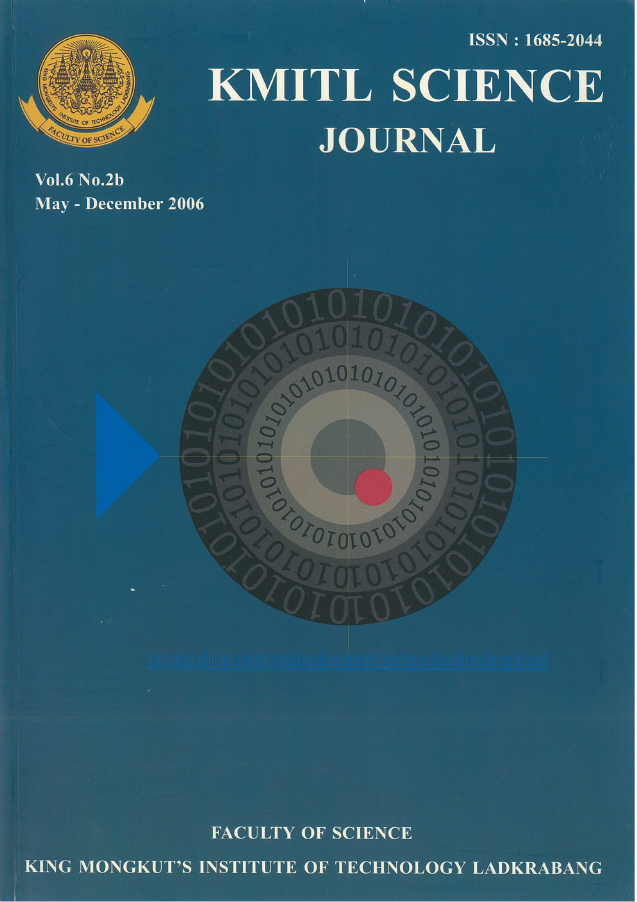Disinfectant Testing for Biofilm Elimination using Modified Capacity Test
Main Article Content
Abstract
Two disinfectants, chlorine solution and the mixture of peracetic acid and hydrogen peroxide solution (PAHP), which widely used in the food industry were examined for their efficiency to eliminate the biofilms compare to the suspended cells using modified capacity test. The tested concentrations of chlorine (200 ppm) and PAHP (0.2% and 0.4%) were effective against the cell suspension of the two test organisms, Staphylococcus aureus and Pseudomomas fluorescens (at least 8 log reduction). No viable colony was observed even when the disinfectants were diluted into half strength of the tested concentration. Whereas the biofilm of the same test organisms gave unsatisfactory results, in particular with the used concentration of PAHP. Furthermore milk showed the greater interfering capacity against the PAHP activity than the chlorine activity when testing with biofilms. Therefore to ensure the full efficiency of disinfection regime in the food industry, the modified capacity test should be applied with the biofilms rather than testing with the planktonic cells.
Keywords: Biofilm, Pseudomomas fluorescens, Staphylococcus aureus, capacity test, disinfectants, peroxyacetic acid, hydrogen peroxide, chlorine
Corresponding author: E-mail: svt@kmitnb.ac.th
Article Details
Copyright Transfer Statement
The copyright of this article is transferred to Current Applied Science and Technology journal with effect if and when the article is accepted for publication. The copyright transfer covers the exclusive right to reproduce and distribute the article, including reprints, translations, photographic reproductions, electronic form (offline, online) or any other reproductions of similar nature.
The author warrants that this contribution is original and that he/she has full power to make this grant. The author signs for and accepts responsibility for releasing this material on behalf of any and all co-authors.
Here is the link for download: Copyright transfer form.pdf
References
[2] Holah, J.T. 2000. Cleaning and Disinfection. In : Dennis, C. and Stringer, M.F., Eds. Chilled Foods: a Comprehensive Guide. Cambridge, Woodhead Publishing, pp. 397-428.
[3] Harrigan, W. F. 1998. Laboratory Methods in Food Microbiology. 3rd Edition. California : Academic Press, pp. 22-26.
[4] Anonymous. 1997. Chemical Disinfectants and Antiseptics-Basic Bactericidal Activity-Test Method and Requirement (Phase 1). BS-EN-1040, London: British Standards Institute, pp. 1-30.
[5] Anoymous. 1998. Chemical Disinfectants and Antiseptics-Quantitative Suspension Test for Evaluation of Bactericidal Activity of Chemical Disinfectants and Antiseptics Used in Food, Industrial, Domestic and Institutional Areas-Test Method and Requirement (Phase 2 step 1). UNE-EN-1276, pp. 1-35.
[6] Brinez, W.J., Roig-Sagues, A.X., Herrero, M.H., Lopez-Pedemonte, T. and Guamis, B. 2006. Bactericidal Efficiency of Peracetic Acid in Combination with Hydrogen Peroxide against Pathogenic and Non Pathogenic Stains of Staphylococcus spp., Listeria spp. and Escherichia coli, Food Control, 17, 516-521.
[7] Holah, J.T., Taylor, J.H. Dawson, D.J. and Hall, K.E. 2002. Biocide Use in the Food Industry and the Disinfectant Resistance of Persistent Strains of Listeria monocytogenes and Escherichia coli, Journal of Applied Microbiology Symposium Supplement, 92, 111S-120S.
[8] Costerton, J.W., Stewart, P.S. and Greenberg, E.P. 1999. Bacterial Biofilms: a Common Cause of Persistent Infections, Science, 284, 1318-1322.
[9] Holah, J.T. 1992. Industrial Monitoring Hygiene in Food Processing. . In: Melo, L.F., Bott, T.R., Fletcher, M. and Capdeville, B., Eds. Biofilms – Science and Technology. Dordrecht : Kluwer Academic Publisher, pp. 645-659.
[10] Cousin, M.A. 1982. Presence and Activity of Psychrotrophic Microorganisms in Milk and Dairy Products: a Review, Journal of Food Protection, 45, 172-207.
[11] Roberts, D. 1991. Source of Infection: Food. In: Waites, W.M and Arbuthnott, J.P., Eds. A Lancet Review Foodborne Illness. London, Edward Arnold, pp. 31-37.
[12] Vatanyoopaisarn, S. 2003. Development of Staphylocococal Biofilms on Stainless Steel Surfaces. Proceeding 5th Agro-Industrial Conference: Innovation of Health Food Products, 30-31 May, BITEC Exhibition Center, Bangkok, pp. 384-387.
[13] Chumkhunthod, P., Schraft, H. and Griffiths, M. W. 1998. Rapid Monitoring Method to Assess Efficacy of Sanitizers against Pseudomonas putida Biofilms. Journal of Food Protection, 61, 1043-1046.
[14] Vatanyoopaisarn, S. 2001. Comparison of Detachment Methods for Biofilm Removal on Glass and Stainless Steel Surface. The Journal of KMITNB, 11, 14-24.
[15] Wei, C.I., Cook, D.L. and Kirk, J.R. 1985. Use of Chlorine Compounds in the Food Industry. Food Technology, 39, 107-115.
[16] Richardson, S.D., Thruston Jr., A.D., Caughran, T.V., Collette, T.W., Patterson, K.S. and Lykins Jr., B.W. 1998. Chemical By-Products of Chlorine and Alternative Disinfectants. Food Technology; 52, 58-61.
[17] www.http://www.epa.gov/oppad001/list_a_sterilizer.pdf.
[18] Troller, J.A. 1993. Sanitation in Food Processing. 2nd Edition,. Ohio, Academic Press.


